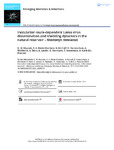2021-12-06Zeitschriftenartikel
Inoculation route-dependent Lassa virus dissemination and shedding dynamics in the natural reservoir – Mastomys natalensis
Wozniak, D. M.
Riesle-Sbarbaro, S. A.
Kirchoff, N.
Hansen-Kant, K.
Wahlbrink, A.
Stern, A.
Lander, A.
Hartmann, K.
Krasemann, S.
Kurth, A.
Prescott, J.
Lassa virus (LASV), a Risk Group-4 zoonotic haemorrhagic fever virus, affects sub-Saharan African countries. Lassa fever, caused by LASV, results in thousands of annual deaths. Although decades have elapsed since the identification of the Natal multimammate mouse (Mastomys natalensis) as a natural reservoir of LASV, little effort has been made to characterize LASV infection in its reservoir. The natural route of infection and transmission of LASV within M. natalensis remains unknown, and the clinical impact of LASV in M. natalensis is mostly undescribed. Herein, using an outbred colony of M. natalensis, we investigate the replication and dissemination dynamics of LASV in this reservoir following various inoculation routes. Inoculation with LASV, regardless of route, resulted in a systemic infection and accumulation of abundant LASV-RNA in many tissues. LASV infection in the Natal multimammate mice was subclinical, however, clinical chemistry values were transiently altered and immune infiltrates were observed histologically in lungs, spleens and livers, indicating a minor disease with coordinated immune responses are elicited, controlling infection. Intranasal infection resulted in unique virus tissue dissemination dynamics and heightened LASV shedding, compared to subcutaneous inoculation. Our study provides important insights into LASV infection in its natural reservoir using a contemporary infection system, demonstrating that specific inoculation routes result in disparate dissemination outcomes, suggesting intranasal inoculation is important in the maintenance of LASV in the natural reservoir, and emphasizes that selection of the appropriate inoculation route is necessary to examine aspects of viral replication, transmission and responses to zoonotic viruses in their natural reservoirs.

